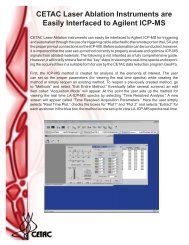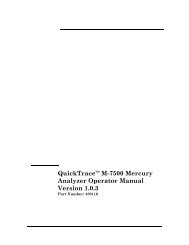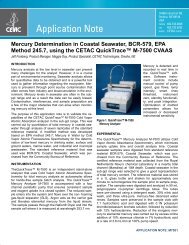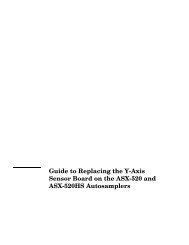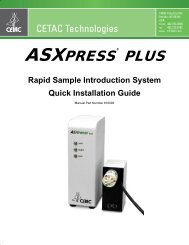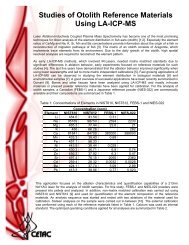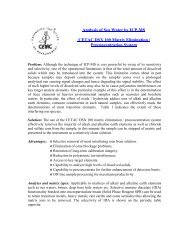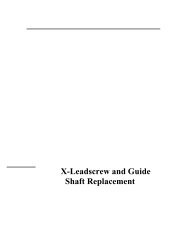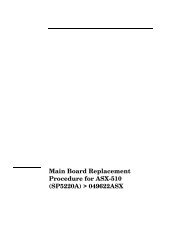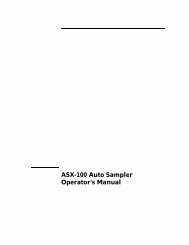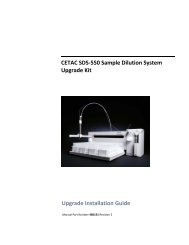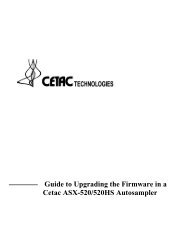CETAC M-7600 Mercury Analyzer Operator's Manual
CETAC M-7600 Mercury Analyzer Operator's Manual
CETAC M-7600 Mercury Analyzer Operator's Manual
Create successful ePaper yourself
Turn your PDF publications into a flip-book with our unique Google optimized e-Paper software.
<strong>CETAC</strong> QuickTrace M-<strong>7600</strong> <strong>Mercury</strong> <strong>Analyzer</strong><br />
Chapter 6: Troubleshooting the <strong>Mercury</strong> <strong>Analyzer</strong><br />
‣ The liquid is 10% stannous chloride solution in 7% HCl.<br />
‣ The reagent is not “old,” precipitated, yellowed, or otherwise oxidized (for<br />
example, by leaving the bottle open overnight).<br />
‣ There is no clog, kink, pinch, or other obstruction in the reagent-tubing<br />
pathway.<br />
‣ The reagent liquid uptake rate is at least 1.5 mL/min at ~ 30% pump rate.<br />
‣ The autosampler sample probe tubing is the standard i.d. optimized for<br />
the mercury system: 1.0 mm i.d. (marked with a double blue band).<br />
‣ The sample uptake is at least 4.5 mL/min at ~ 30% pump rate.<br />
‣ The autosampler probe, reagent uptake tube, QuickTrace M-<strong>7600</strong> mixing<br />
tee and GLS liquid/mix capillary inlet is not under pressure from a partial<br />
clog.<br />
Poor Reproducibility<br />
‣ Always be sure to matrix match standards and samples as closely as<br />
possible (excluding the 7% HCl in the standards), and rinse solution<br />
should also be acidified.<br />
‣ Inspect the liquid flow into and out of the Gas-Liquid Separator. If either<br />
the sample in or waste out is pulsing, adjust the clamp tension on the<br />
corresponding tubing in the peristaltic pump to smooth out flows. If<br />
unable to stop the pulsing, check to see if the pump tubing is worn out. If<br />
so, replace the pump tubing. Be sure to check all the pump tubes.<br />
‣ Ensure the center post is fully “wet.” If partially dry anywhere on post<br />
surface, wet the post. See page 84.<br />
‣ Check to see if the reagent tube is in the reagent bottle.<br />
‣ Ensure that the stannous chloride has not been emptied or oxidized. Old<br />
SnCl 2 can lead to poor results. Replace if yellow, precipitated, or just too<br />
old.<br />
‣ Ensure that the autosampler rinse station and rinse bottle are filled with<br />
acidified rinse.<br />
‣ Inspect both cell windows for fingerprints, films, or debris. If dirty, clean<br />
the windows following the procedure on page 107.<br />
‣ Make sure gas pressure to the QuickTrace M-<strong>7600</strong> is 120 psig (825 kPa).<br />
‣ Check the output gas flow after the KMnO 4 gas trap with a flow meter (to<br />
check this flow, all pump tubes must be clamped or plugged). This gas flow<br />
should be the same as set in the software. Check all the seals and<br />
recalibrate if necessary. Note calibration and flow stability.<br />
‣ Check the gas flow at the GLS exit.<br />
‣ Check the gas flow at the sample cell exit.<br />
‣ Check that the optimal instrument settings are employed. See “Using the<br />
<strong>Analyzer</strong>” beginning on page 75, the QuickTrace M-<strong>7600</strong> help file, or the<br />
QuickTrace M-<strong>7600</strong> <strong>Mercury</strong> <strong>Analyzer</strong> Software <strong>Manual</strong> for more details.<br />
143



